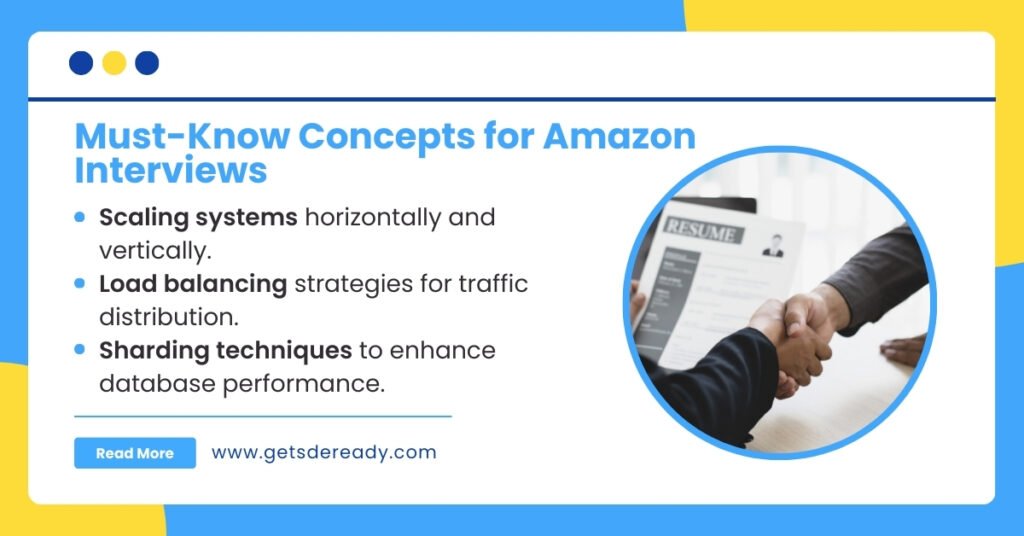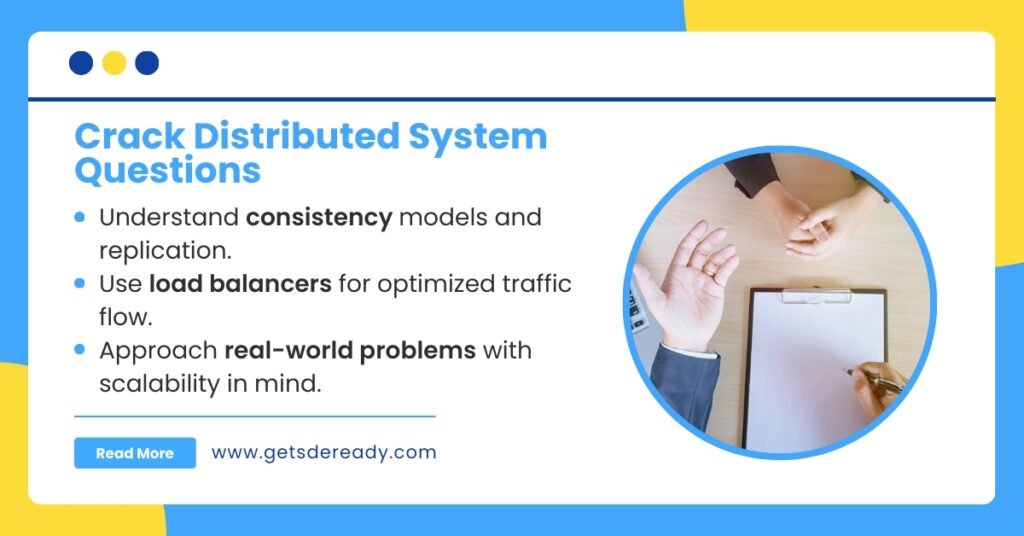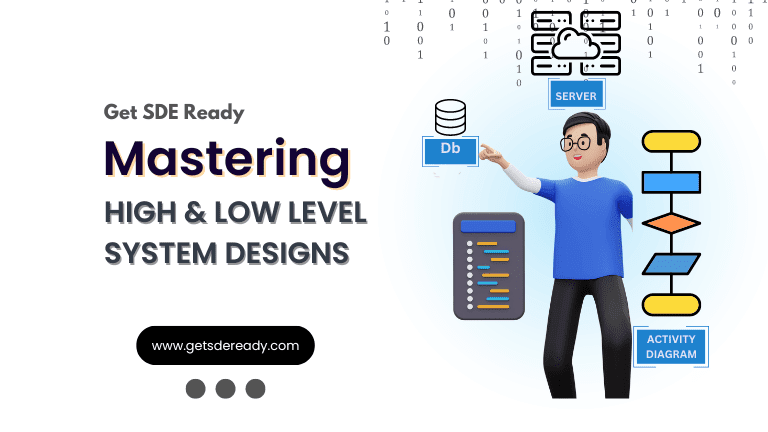
Top Amazon System Design Interview Questions and Preparation Guide
Preparing for a system design interview at Amazon can be challenging, as it requires both theoretical knowledge and practical experience. This guide provides insights into top questions, preparation strategies, and essential concepts to help you ace your interview.
Why Are System Design Interviews Important at Amazon?
Understanding the Interview Objective
Amazon’s system design interviews aim to assess candidates’ ability to build scalable, robust, and efficient systems. They are crucial for roles requiring architecture-level decision-making.
- Demonstrates problem-solving skills.
- Evaluates understanding of scalability and performance.
- Assesses collaborative and innovative thinking.
Key Characteristics Evaluated
Amazon places emphasis on several characteristics during these interviews:
- Scalability: Ability to design systems that handle growth.
- Resilience: Ensuring fault tolerance in design.
- Optimization: Designing for cost-effectiveness and efficiency.
Feature | Key Consideration |
Scalability | Can handle increasing loads |
Fault Tolerance | Works during component failure |
Efficiency | Optimal resource utilization |
Common Amazon System Design Interview Questions
How Would You Design a URL Shortener?
A URL shortener reduces long URLs into compact links while redirecting users accurately. This problem assesses understanding of databases, hashing, and scalability.
- Core Requirements:
- Convert long URLs to unique short links.
- Ensure high availability and low latency.
- System Features:
- Custom URL aliasing.
- Analytics for tracking usage.
List of Important Considerations:
- Efficient database schema for storing URLs.
- Strategies for hash collision resolution.
- Load balancing for handling traffic spikes.
Aspect | Example Tools/Techniques |
Database | MySQL, DynamoDB |
Hashing Algorithm | Base62 encoding |
Load Balancing | Round-robin, Consistent Hashing |
How Would You Design an Online Store?
Designing an online store demonstrates your understanding of e-commerce functionalities, data storage, and microservices architecture.
- Core Functionalities:
- Product catalog with search capabilities.
- User authentication and shopping cart.
- Payment gateway integration.
- Challenges:
- Managing inventory.
- Handling traffic during peak sales events.
System Components:
- Use caching for faster product searches.
- Implement a message queue for order processing.
- Employ a CDN for delivering static assets.
Component | Best Practices |
Search Optimization | ElasticSearch integration |
Order Management | Event-driven architecture |
Static Content | Content Delivery Network |
How Would You Design a Chat Application?
A chat application involves real-time communication between users. Key aspects include scalability, low latency, and data consistency.
- Core Requirements:
- One-on-one and group chats.
- Message delivery acknowledgment.
- Offline message storage.
- Advanced Features:
- End-to-end encryption.
- Typing indicators and read receipts.
Steps to Approach the Problem:
- Choose WebSockets for real-time communication.
- Use distributed databases for message storage.
- Implement rate limiting to prevent abuse.
Feature | Implementation Tools |
Real-Time Updates | WebSockets, SignalR |
Message Storage | Cassandra, DynamoDB |
Encryption | AES, RSA |
How to Structure Your Answers During the Interview

Clarify the Problem Statement
Understanding the interviewer’s expectations is crucial:
- Ask questions to gather requirements.
- Confirm assumptions about user base and traffic.
- Identify functional and non-functional requirements.
Break Down the Solution
Organize your response into clear sections:
- High-Level Overview:
- Start with an architectural diagram.
- Highlight core components and interactions.
- Detailed Explanation:
- Dive into each component’s role.
- Discuss trade-offs and optimization strategies.
Common Pitfalls to Avoid
- Overcomplicating solutions.
- Ignoring edge cases.
- Failing to address scalability or fault tolerance.
Step | Action |
Clarify Requirements | Gather detailed needs |
Structure Response | Use logical flow and diagrams |
Highlight Trade-offs | Discuss pros and cons |
Essential Concepts to Master for Amazon System Design

Scalability and Load Balancing
Designing systems to scale involves both horizontal and vertical scaling techniques.
- Horizontal Scaling:
- Adding more servers to handle load.
- Vertical Scaling:
- Increasing resources of existing servers.
- Increasing resources of existing servers.
Load Balancing Strategies:
- Use round-robin for equal traffic distribution.
- Implement health checks for detecting server failures.
Scaling Type | Key Advantages |
Horizontal | Improved fault tolerance |
Vertical | Easier to implement |
Database Sharding
Sharding splits data into smaller, manageable parts to enhance performance.
- Key Approaches:
- Range-based sharding.
- Hash-based sharding.
- Benefits:
- Reduces query latency.
- Balances database load.
Important Considerations:
- Avoid hotspots by choosing the right shard key.
- Monitor shard health and re-balance when needed.
Sharding Technique | Use Case |
Range-Based | Sorted queries |
Hash-Based | Uniform distribution |
Understanding Amazon’s Approach to Scalability in System Design
Amazon is synonymous with scalability. Its systems are designed to handle billions of transactions daily while maintaining high performance and reliability.
How Amazon Ensures Scalability in its Systems
Scalability is at the core of Amazon’s engineering principles. The company prioritizes distributed architectures, microservices, and data partitioning to ensure systems scale effectively under load. By leveraging Amazon Web Services (AWS), the company utilizes elastic computing to dynamically adjust resources.
- Distributed architecture: Helps distribute load across multiple servers to avoid bottlenecks.
- Microservices: Allows independent scaling of different components of a system.
- Elastic computing: Dynamically scales resources based on traffic demands.
Key Metrics for Measuring Scalability at Amazon
Scalability is measured through several performance metrics. Amazon relies on latency, throughput, and system availability to evaluate system performance under various conditions.
- Latency: Measures response time for user requests.
- Throughput: Indicates the number of transactions a system can process.
- Availability: Ensures the system remains operational during peak traffic.
Example Metrics Table
Metric | Description | Importance to Scalability |
Latency | Time taken to respond to a request | Ensures quick user experience |
Throughput | Number of requests handled per second | Determines system capacity |
Availability | Percentage of uptime during operations | Maintains reliability |
Key System Design Principles for Amazon Interviews
Amazon evaluates candidates on their understanding of design principles that align with its operational philosophy.
Design for Fault Tolerance
Fault tolerance is essential in ensuring system reliability, especially at Amazon’s scale. Systems must be resilient to component failures without affecting overall functionality.
- Redundant architecture: Mitigates single points of failure.
- Error recovery protocols: Ensures systems can recover from unexpected issues.
Prioritize Data Partitioning and Sharding
Efficient data management is critical for scalability. Amazon’s systems use data partitioning to divide and distribute datasets across servers.
- Horizontal scaling: Increases capacity by adding more machines.
- Sharding strategies: Optimize database queries for performance.
Ensure Security in System Design
Amazon emphasizes security as a design principle. Safeguarding data and ensuring secure communication between components are non-negotiable.
- Encryption protocols: Protect data at rest and in transit.
- Authentication systems: Validate user access securely.
How to Ace Distributed Systems Questions at Amazon

Distributed systems are a recurring theme in Amazon’s system design interviews. Here are key strategies to excel.
Understand the Fundamentals of Distributed Systems
Distributed systems form the backbone of Amazon’s infrastructure. Interviewers often ask questions that assess your understanding of distributed computing concepts.
- Consistency models: Understand strong, eventual, and causal consistency.
- Replication techniques: Learn about leader-follower and quorum-based replication.
Master Load Balancing Techniques
Load balancing ensures equitable distribution of traffic across servers. Amazon relies heavily on load balancers to optimize system performance.
- Algorithm selection: Different scenarios require specific algorithms like round-robin or least-connections.
- Health checks: Regularly monitor server health to avoid routing traffic to unavailable nodes.
Demonstrate Problem-Solving with Real-World Scenarios
Many Amazon system design questions simulate real-world problems. Practice designing solutions for scenarios like building a content delivery network (CDN) or a distributed database.
- Scenario-based design: Approach problems methodically, considering scalability, reliability, and cost.
- Trade-offs analysis: Explain the reasoning behind your design decisions.
Common Distributed Systems Topics in Amazon Interviews
Topic | Key Focus | Example Question |
Consistency models | Balancing trade-offs | How do you design a consistent system? |
Load balancing | Optimization techniques | Design a global load balancer. |
Fault tolerance | Resilience strategies | Build a fault-tolerant database. |
Accelerate your Path to a Product based Career
Boost your career or get hired at top product-based companies by joining our expertly crafted courses. Gain practical skills and real-world knowledge to help you succeed.
Reach Out Now
If you have any queries, please fill out this form. We will surely reach out to you.
Contact Email
Reach us at the following email address.
Phone Number
You can reach us by phone as well.
+91-97737 28034
Our Location
Rohini, Sector-3, Delhi-110085








